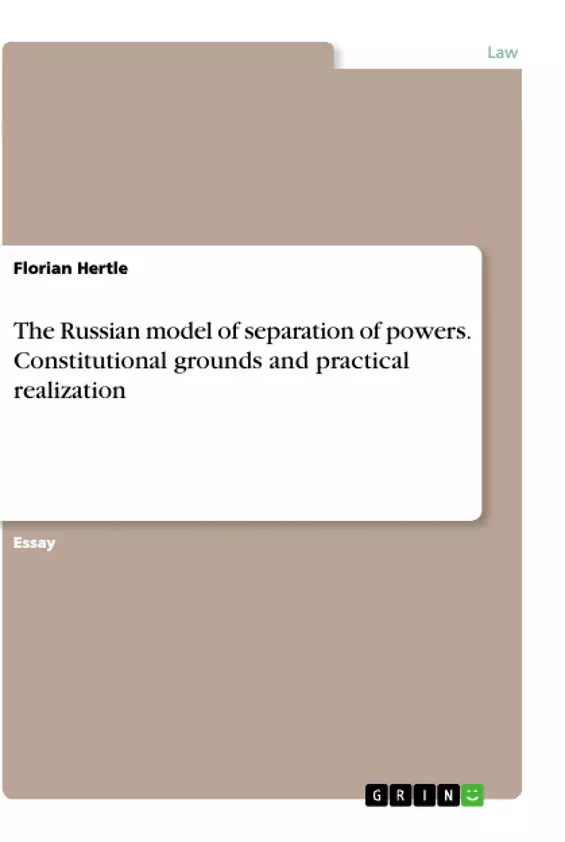The constitution of the Russian Federation (CoRF) from 1993 states in Article 1 (1) that the Russian Federation is a democratic state. Therefore, it is interesting to analyze the realization of the separation of powers in Russia in two perspectives: in terms of the legal grounds and also concerning its practical realization.
As the predecessor states of the Russian Federation weren’t democracies in the western sense of the term, this research can provide insights how the separation of powers principle is managed in a newly democratized state.
Thus, the role of separation of powers in the Russian Federations predecessor states will be analyzed, before the constitutional norms concerning the separation of powers will be investigated. In addition, the practical handling of separation of powers in the Russian Federation will be discussed and it will be given a short conclusion.
Inhaltsverzeichnis (Table of Contents)
- The role of separation of powers in the predecessor states of the Russian Federation
- The Tsarist era
- The Soviet era
- The constitutional norms concerning the separation of powers
- The 1993 constitution
- The constitutional amendments in 2020
- Practical handling of the separation of powers
- Presidential power
- Accountability of the Government
- Role of other branches
- Conclusion
Zielsetzung und Themenschwerpunkte (Objectives and Key Themes)
This research aims to analyze the realization of the principle of separation of powers in Russia, focusing on both the legal framework and its practical implementation. The study explores the evolution of this principle in the context of the Russian Federation's predecessor states, which were not democracies in the Western sense. This allows for insights into how the separation of powers principle is managed in a newly democratized state.
- The historical evolution of the separation of powers principle in Russia
- The constitutional provisions governing the separation of powers in the Russian Federation
- The practical implementation of the separation of powers principle in Russia
- The impact of the 2020 constitutional amendments on the separation of powers
- The role of the President in the Russian political system
Zusammenfassung der Kapitel (Chapter Summaries)
Chapter 1: The role of separation of powers in the predecessor states of the Russian Federation
This chapter analyzes the historical evolution of the separation of powers principle in Russia, examining its role in both the Tsarist and Soviet eras. It highlights the absence of a true separation of powers under Tsarist rule and the Soviet Union's rejection of the principle as a "bourgeois fiction."
Chapter 2: The constitutional norms concerning the separation of powers
This chapter focuses on the constitutional provisions governing the separation of powers in the Russian Federation. It examines the 1993 constitution and its articulation of the principle of separation of powers, highlighting the roles of various branches of government and the limitations on their independence. The chapter then explores the impact of the 2020 constitutional amendments on the separation of powers.
Schlüsselwörter (Keywords)
This research delves into the separation of powers principle in Russia, focusing on its constitutional framework and practical implementation. Key themes include the historical development of this principle in the context of the Tsarist and Soviet eras, the role of the President in the Russian political system, and the impact of the 2020 constitutional amendments. The study explores the balance between power and accountability in the Russian Federation, examining how the separation of powers doctrine is interpreted and practiced in a newly democratized state. It also considers the concept of "superpresidentialism" and its implications for the independence of other branches of government.
- Quote paper
- Florian Hertle (Author), 2020, The Russian model of separation of powers. Constitutional grounds and practical realization, Munich, GRIN Verlag, https://www.grin.com/document/595346



